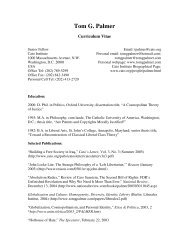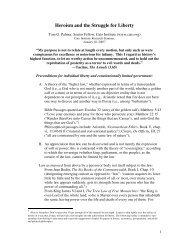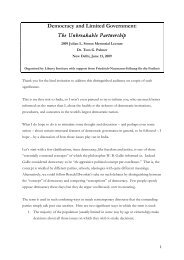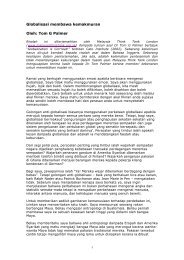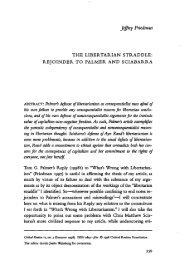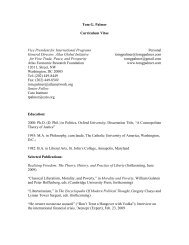Are Patents and Copyrights Morally Justified? - Tom G. Palmer
Are Patents and Copyrights Morally Justified? - Tom G. Palmer
Are Patents and Copyrights Morally Justified? - Tom G. Palmer
You also want an ePaper? Increase the reach of your titles
YUMPU automatically turns print PDFs into web optimized ePapers that Google loves.
S54 HarvardJournal ofLaw & Public Policy [Vol, 13<br />
by publishing a work that I had heard another recite? What ifI<br />
recorded a broadcast on my VCR? Does the broadcaster own<br />
my television set <strong>and</strong> reserve the right to determine its use in<br />
recording signals that come over the airwaves? 140 Ifthe answer<br />
is yes, then advocates of a “piggy-back” copyright cannot base<br />
their argument simply on a retained right to tangible property,<br />
for this amounts to asserting a direct claim to the ideal object<br />
itself. 141<br />
Rothbard would have been far better offlooking to the law of<br />
trade secrets rather than to the law of copyright as a foundation<br />
for retained-right, or quasi-contractual legal exclusivity in the<br />
results of a creator’s efforts. Under the law of trade secrecy,<br />
“trade secrets are not given protection against all the world,<br />
but only against one who has learned the secret by improper<br />
means or by virtue of a confidential relation.” 42 Thus, ifa secret,<br />
such as a manufacturing process, a design, or the internal<br />
operation of a device, is revealed to others who are not bound<br />
140. Ifan advocateof”piggy-back rights” were to respond that the airwavescan <strong>and</strong><br />
should be the objects ofownership, as somehaveargued, he would revealamisunderst<strong>and</strong>ing<br />
of the status of “the airwaves.” One cannot own the broadcast spectrum,<br />
although one can havetheright to useone’s broadcastingor receiving equipmentwithout<br />
interference from others. Thus, the first broadcaster over a frequency in a given<br />
areacan have alegally recognized right tobroadcast overa partofthe electro-magnetic<br />
spectrum without interfering with another broadcaster. But ifanother broadcaster can<br />
send out a narrow beam signal within that spectrum that does not interfere with the<br />
first broadcaster’s signal (<strong>and</strong>hence with his use ofhis tangible property), then thefirst<br />
should have no right to stop the second. As Ronald Coase argues, assigning direct<br />
property rights over thebroadcast spectrum is as sensible as assigning direct property<br />
rights over “the notes of the musical scale or the colors of the rainbow.” Coase, The<br />
Federal Communications Commission, 2J.L. & EC0N. 1, 35(1959). In aprivateproperty systeIn,<br />
“if there were a market, what would be sold, is the right to use apiece ofequip.<br />
ment to transmit signals in a particular way.” Id. The right in question would be a right<br />
over a tangible object, not over the immaterial broadcast spectrum See also Mueller,<br />
Reforming Telecommunications Regulation, in TELECOMMUNICATIONS IN Caisis: THE FIRST<br />
AMENDMENT, TECHNOLOGY, AND DEREGULATION 95-100 (1988).<br />
141. The general thrust of Rothbard’s overall argument for property seems to be<br />
consistent with the ‘~justice-as-order”notion, although he sometimes does not make<br />
thedistinctions necessary in order to address intellectual property issues. Thus, Rothbarddefendstheproperty<br />
right of asculptor’screation without distinguishing between<br />
thedifferentways in which thesculptormight own his “product,” like ownership ofthe<br />
material artifact, or ownership of the form embedded in it: “[T]he sculptorhas in fact<br />
‘created’ this work of art—not of course in the sense that he has created matter—but<br />
that he has produced it by transforming nature-given matter (the clay) into another<br />
form in accordance with his own ideas <strong>and</strong> his own labor <strong>and</strong> energy. Surely, if every<br />
man has the right to own his own body, <strong>and</strong> if he must use <strong>and</strong> transform material<br />
natural objects in order to survive, then he has theright to own the product that he has<br />
made, by his energy <strong>and</strong> effort, into a veritable extension of his own personality.” M.<br />
ROTHBARD, THE ETHICS OF LIBERTY 48 (1983).<br />
142. W. KINTNER & J. LAHR, AN INTELLECTUAL PROPERTY LAW PRIMER 168 (1982)<br />
(quoting Carver v. Harr, 132 N.J. Eq. 207, 209, 27 A.2d 895, 897 (1942)).




